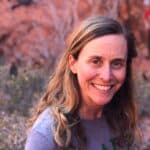The extent of microplastic occurrence in Juneau, Alaska and potential effects of plastic-born chemicals on these environments
August 18, 2021 @ 10:00am (AKDT)
On August 18, we hosted a second microplastic-themed webinar with Dr. Sonia Nagorski from the University of Alaska Southeast. Dr. Nagorski has decades of experience studying water quality as an environmental geochemist and recently turned her attention to the emerging issue of microplastic contamination. Plastic is a material unknown to Earth prior to recent decades but has rapidly become a persistent and pervasive global pollutant. Together with a group of UAS undergraduates, Dr. Nagorski is conducting original investigations into the extent of microplastic occurrence in glaciers, rivers, beaches, rain, and snow in Juneau, Alaska.
We were also joined by Pamela Miller, the Executive Director of Alaska Community Action on Toxics, who shared findings from an upcoming ACAT report on plastics, chemicals, and climate in Alaska, highlighting the most pressing health concerns related to plastic pollution in the Arctic and links to extractive industries in Alaska.
The Role of Plastic on Human Health https://pubmed.ncbi.nlm.nih.gov/29359236/
Plastics, EDC’s & Health: Authoritative Guide published by the Endocrine Society and IPEN https://www.endocrine.org/topics/edc/plastics-edcs-and-health
The Basel Convention’s overview on plastic waste http://www.basel.int/Implementation/Plasticwaste/Overview/tabid/8347/Default.aspx
Phthalate Fact Sheet produced by Alaska Community Action on Toxics https://www.akaction.org/wp-content/uploads/Phthalates_ACAT2.pdf
The Plastic Pollution Coalition https://www.plasticpollutioncoalition.org/
Plastic Is Falling From The Sky: But Where’s It Coming From? (April, 2021) published in Wired – https://www.wired.com/story/plastic-is-falling-from-the-sky/. The scientific article was published in April, 2021 and is entitled ‘Constraining the atmospheric limb of the plastic cycle’ https://www.pnas.org/content/118/16/e2020719118
Plasticenta: First evidence of microplastics in human placenta (January, 2021) published in Environment International https://www.sciencedirect.com/science/article/pii/S0160412020322297
Microplastics Have Moved into Virtually Every Crevice on Earth (August, 2020) by National Geographic https://www.nationalgeographic.com/science/article/microplastics-in-virtually-every-crevice-on-earth
Where’s Airborne Plastic? Everywhere, Scientists Find (June, 2020) in the New York Times https://www.nytimes.com/2020/06/11/climate/airborne-plastic-pollution.html
From National Parks to the Deep Sea, Plastic Pollution is Turning up Everywhere Scientists Look (June, 2020) in the Washington Post https://www.washingtonpost.com/weather/2020/06/14/national-parks-deep-sea-plastic-pollution-is-showing-up-wherever-scientists-look/
Plastic Fragments Found for the First Time on Glacier (April, 2019) in EOS https://eos.org/articles/plastic-fragments-found-for-the-first-time-on-a-glacier
Microplastics in Arctic Sea Ice Should Concern Everybody (January, 2019) in Arctic Today https://www.arctictoday.com/microplastics-in-arctic-sea-ice-should-concern-everybody/
Featured speakers

Dr. Sonia Nagorski is an Associate Professor of Geology at the University of Alaska Southeast with a focus on environmental geochemistry and water quality. Dr. Nagorski has a M.Sc. and Ph.D. in Geology from the University of Montana, and much of her research examines the presence and sources of contaminants such as trace metals and black carbon in both natural and anthropogenically impacted stream and glacial systems. In addition, a recent investigation she participated in with several UAS undergraduates examined an emerging contaminant in her local waterways – microplastics.

Pamela Miller is the Executive Director of Alaska Community Action on Toxics and Co-Chair of IPEN, the International Pollutants Elimination Network. She is also Pam is a leader in Coming Clean, a national network of groups concerned about chemicals policy reform, and in the Collaborative on Health and the Environment, an international partnership committed to strengthening the scientific and public dialogue on environmental factors linked to chronic disease and disability.
